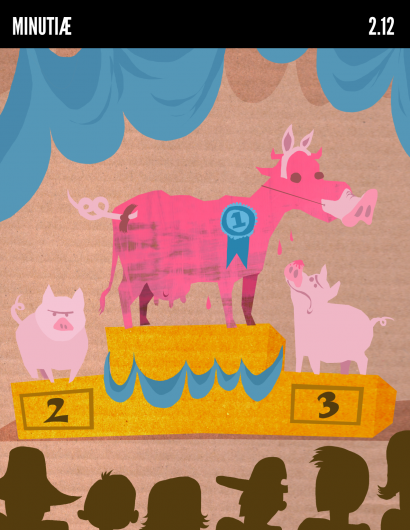Skill Games — Cluedo
by Michael Matzke
For Hasbro’s 1977 UK-only release Cluedo: Masters Edition, the manufacturer included a small, untitled leather-bound handbook. The detailed addendum provides the most ardent Cluedo fans with painstakingly descriptive information regarding the particulars of the game. It is unknown how many copies of the handbook exist, but at a recent auction by Sothebys one copy sold for £450,000.
Characters
Colonel Lance Briwyck Mustard III, “Colonel Mustard” (16 October 1910 — ??) is a British colonialist and wealthy tea magnate. Born in poverty-stricken Witsfordshire, he was the son to a pair of professional puppeteers, Moraine and Lancely Mustard.
Colonel Mustard earned his wealth as an ivory trader on Africa’s Ivory Coast. He would later found the Northwestern Indo-Chino Tea Company in the Xishuang Prefecture of China’s Hunan Province. Colonel Mustard has a strong penchant for Zhenghe Gongfu black tea, which is the company’s biggest commercial success to date.
Lead poisoned from his tea-addicted youth, Colonel Mustard is prone to extreme day terrors. These usually come in the form of close friends morphing into ancient Mughal pirates attempting to seize his ship. The Colonel is four feet tall.
Professor Kenneth Plum, formerly known as Associate Professor Kenneth Ng, “Professor Plum” (16 July 1923 — ??) is a famed Canadian archeologist with a specialization in Neanderthal studies. Born in Gander, he matured beside the shadows of large machines. His father, Perry Plum, patented the process for margarine-making in Canada by combining whale, seal, and fish oil. As a result of fumes from the margarine production, Professor Plum’s body radiates a pungent fishy smell.
Educated at Masaryk University in the Czech Republic, he graduated first in class and went on to uncover a Neanderthal burial ground in the Croatian wilderness. Shortly thereafter, he fell in love with fellow Associate Professor Betty Ng and married her. He legally changed his name to Kenneth Ng in 1954, which lasted until the couple’s divorce in 1956. Professor Plum is the recipient of the 1959 Ironshard Award for Greatest Initiative in Neanderthal Excavation.
The Professor hunts quail, and owns several antique guns. He is an avid fan of the Swedish band ABBA.
Shannon Rose Peacock, “Mrs. Peacock” (2 January 1914 — ??) is a British socialite and actress. Her grandfather Arthur Peacock was a wealthy Purging Buckthorn tree farmer who passed on a significant inheritance to his children. Miss Peacock grew up as a young heiress in South London and was deemed by many parents in the neighborhood as a “psychotic lunatic.”
In 1936, Miss Peacock received her Fine Arts degree at Swinneywine University. After graduating, she landed the infamous role of Langly the Slag in Look Who’s All Gussied Up? (1937) which garnered unfavorable reviews for her portrayal of a boisterous and racially-insensitive prostitute. Miss Peacock would enjoy performing in smaller roles throughout the rest of her career.
While doing voiceover work as a Mary the Quill Slag in the animated children series Parliamentary Party (1939), Miss Peacock met her first husband Duke Prince Kingsley, then a guest on the program.
Mrs. Peacock’s romantic exploits have caught the eyes of the British authorities in recent years: all eight of her former husbands have died of drowning accidents, and all were Dukes.
Rooms
Conservatory (4 March 1968 — ??) is a former “sunroom” stripped of its lovely curved windows in early 1968. Retrofitted with almond-colored shag carpet and lava lamps, the beautiful room is a shell of its former self.
Guests routinely complain about the smell of opium and body sweat seeping from the walls.
Study (4 March 1968 — ??) is a private and personal room located in the east wing of the home. Overwhelmed by the accomplishments of its brother, the Library, the Study acts a haven for homosexuals and the illiterate class.
Its dimly-lit ambiance provides the perfect setting for illicit happenings.
Library (4 March 1968 — ??) is a very popular and well-known room made of ancient rosewood.
The Library is a 1968 & 1970 Bounded Pages award-winner for the Grandest Library in the World. It has been used in several popular British films — Please Murder Me (1968), Filthy Drifter (1974), and the upcoming The Muppet Movie with a scheduled release of Spring 1979.
The room has been witness to several neckless children who appear as ghosts. These ghosts often chase after young women who they contend are their mummies. The residence’s owner vehemently denies the accusations and the facility continues to operate in a professional manner.
Cellar with envelope (4 March 1968 — ??) is a mysterious room primarily occupied by a large envelope with unknown contents. The envelope is a private matter, with no intention of entertaining solicitors.
According to guests, the walls are constantly dripping with fresh blood.
Objects
Lead Pipe (12 June 1973 — ??) is an object that transfers liquids and solids, and appears in such household items as sinks and tubs. The lead pipe was primarily used in the toilet of the residence until it was later disassembled.
At present day, the lead pipe resides in the Conservatory hidden amongst a pile of copper pipes.
Rope (6 August 1976 — ??) is a strand of fibers that are braided together to improve leverage and strength. The rope was manufactured in Middle Essex, England by the Monty Corporation.
Primarily used for sails, it is now used in conjunction with drapes in the Study.
Dagger (3 February 1970 — ??) is an ancient weapon with a sharp point and made of metal. It is used for stabbing and thrusting.
Until recently, it resided inside the envelope in the Cellar; however, its whereabouts are currently unknown.
Candlestick (1 March 1964 — ??) is a brass instrument designed to hold candles atop a mantelpiece or a dining table. It is less gaudy than its relative, the candelabra. The candlestick was first purchased in a Dillard’s department store in upstate Ohio in the 1960’s, suffering at creation from a crooked base.
It is four inches tall. ♦
